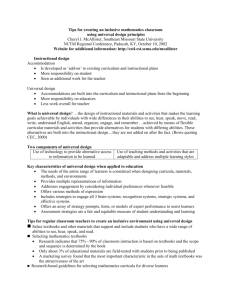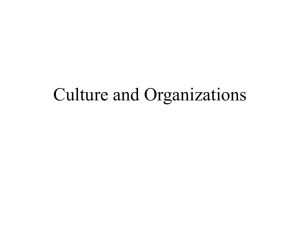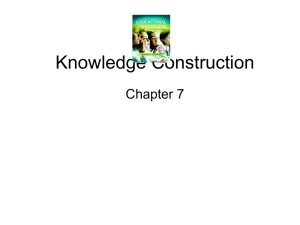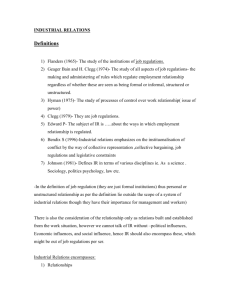tesl.3240.lecture3
advertisement
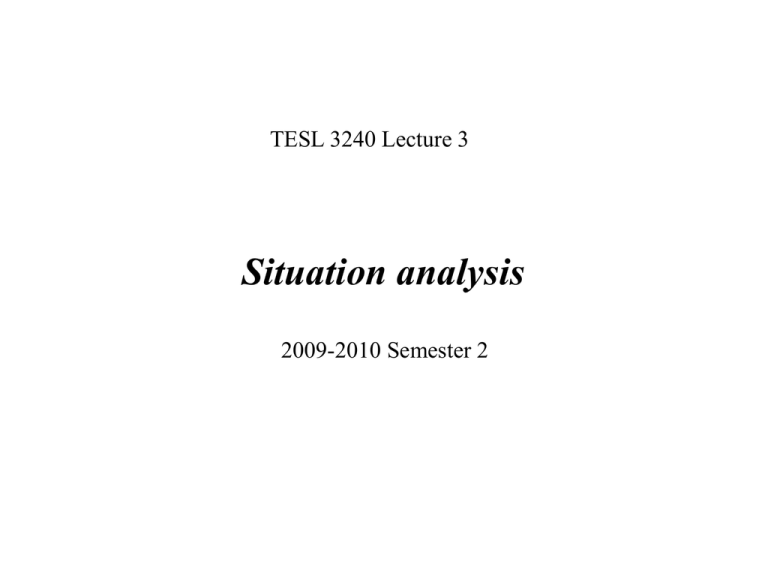
TESL 3240 Lecture 3 Situation analysis 2009-2010 Semester 2 What is situation analysis • Situation analysis is an analysis of factors in the context of a planned or present curriculum, project that is made in order to assess their potential impact on the project. • These factors may be political, social, economic, or institutional. • Situation analysis complements the information gathered during needs analysis. • It is sometimes considered as a dimension of needs analysis, and can also be regarded as an aspect of evaluation. Societal factors In examining the impact of societal factors on language teaching, therefore, the aim is to determine the impact of groups in the community or society at large on the program. • • • • • • • • • • These groups include: Policy makers in government Educational and other government officials Employers The business community Politicians Tertiary education specialists Educational organisations Parents Citizens Students In the case of projects of community or national scope, questions such as the following may be relevant: • What current language teaching policies exist and how are they viewed? • What are the underlying reasons for the project and who supports it? • What impact will it have on different sectors of society? • What language teaching experience and tradition exist in the country? • How do members of the public view second languages and second language teaching? • What are the views of relevant professionals such as academics and teacher trainers? • What do professional organizations such as teachers’ unions think of the project? • What are the views of parents and students? • What are the views of employers and the business community? Project factors The following project factors need to be considered: • Who constitutes the project group and how are they selected? • What are the management and other responsibilities of the team? • What community resources are available to support the innovations, such as radio, television, and the media? • How are goals and procedures determined? • Who reviews the progress of the project and the performance of its members? • What experience do members of the team have? • How do members of the team regard each other? • What resources do they have available and what budget to acquire needed resources? • What is the time frame of the project? Is it realistic, or is more or less time needed? Institutional factors Institutional factors relate to the following kind of questions: 1.What leadership is available within the school to support change and to help teachers cope with change? 2.What are the school’s physical resources, including classroom facilities, media and other technological resources, and library resources? 3.What is the role of textbooks and other instructional materials? 4. What is staff morale like among English teachers? 5. What problems do teachers face and what is being done about them? 6. What administrative support is available within the school and what is communication like between teachers and the administrations? 7. What kind reputation does the institution have for delivering successful language program? 8. How committed is the institution to attaining excellence? Teacher factors • What kinds of teachers currently teach in the target schools or institutions? What is their typical background,training, experience, and motivation? • How proficient are they in English? • What kinds of beliefs do the teachers typically hold concerning key issues in teaching? • What teaching loads do teachers have and what resources do they make use of? • What are the typical teaching methods teachers use and believe in? • To what extent are teachers open to change? • What opportunities do they have for retaining through in-service or other kinds of opportunities? • What benefits are the proposed new syllabus, curriculum, or materials likely to offer teachers? Learner factors • What are learners’ past language learning experience? • How motivated are the learners to learn English? • What are their expectations for the program? • Are they a homogenous or heterogenous group? • What type of learning approach do they favour?(e.g.,teacher-led, student-focused, or small-group work) • What type of content do they prefer? • What expectations do they have for the roles of teachers, learners, and instructional materials? • How much time can be they expected to put into the program? • What learning resources will they typically have access to? Adoption factors • What advantages does the curriculum change offer? Is the innovation perceived to be more advantageous than current practices? • How comparable is it? `Is the use of the innovation consistent with the existing beliefs, attitudes, organisation, and practices within a classroom or school? • Is the innovation very complicated and difficult to understand? • Has it been used and tested out in some schools before all schools are expected to use it? • Have the features and benefits of the innovation been clearly communicated to teachers and institutions? • How clear and practical is it? Are the expectations of the innovation stated in ways which clearly show how it can be used in the classroom? (Morris 1994,109) Profiling the factors identified in the situation analysis • The goal of situation analysis is to identify key factors that might positively or negatively affect the implementation of a curriculum plan. • This is sometimes known as a SWOT analysis because it involves an examination of ‘a language program’ internal strengths and weaknesses in addition to external opportunities and threats to the existence or successful operation of the language program Summary • Situation analysis thus serves to help identify potential obstacles to implementing a curriculum project and factors that need to be considered when planning the parameters of a project. Discussion questions and activities 1. Discuss a language teaching context you are familiar with and list some of the most important factors that are likely to influence the success of the program. 1. How do societal factors influence or have an impact on a language program that you are familiar with? Which factors are negative and which are positive? How can negative factors be addressed? 2. How do societal factors influence or have an impact on a language program that you are familiar with? Which factors are negative and which are positive? How can negative factors be addressed? 3. Are you familiar with a situation in which a curriculum change was attempted(e.g.., the introduction of a new teaching approach, a new textbook, or a new program design) and met with difficulties? Could the problems have been avoided? 4. List the factors that you think are most crucial in a school or institution in creating a favorable context for curriculum change, such as when a new course or language program is being offered for the first time? 5. What groups in the community or society at large would be most relevant to consult in your country( or the country in which you work) in relation to planned changes in the English-or foreign language curriculum in public schools? 6. Have you worked as a member of a curriculum project team( as a material writer, course planner etc.)? Discuss your experience on the project and whether project factors has an impact on the dynamics and outcome of the project. 7. What can be done in circumstances where teachers and learners have different expectations and beliefs about the nature of a language course? 8. What support is provided for teachers in your teaching situation? How effective is the support provided? What other forms of support would you recommend? 9. Imagine that a new technology-based learning program is to be introduced into schools in your country or the country in which you work. The program employs print materials but also makes extensive use of CALL software, CD-ROMS, videos, and other electronic media. What factors might affect the reception of the program and how could any negative factors be addressed? 10. Examine the situation analysis profile in Appendix 1 and adapt it to make it applicable to a context for curriculum change (e.g., introduction of a new curriculum, new teaching methods, new textbooks, a new language program) that you are familiar with. Identify positive and negative factors in the situation that will affect the curriculum change.


